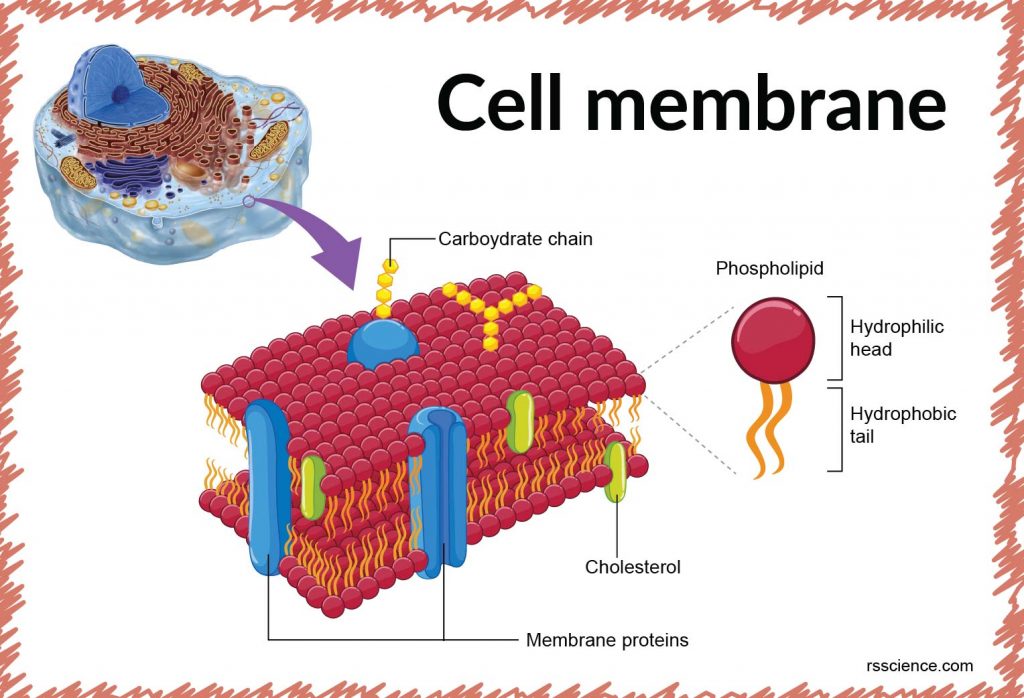This article covers
What is a cell membrane? A quick overview
Our cell is literally a balloon filled with water (70% of our body weight is water). This soft but tough balloon is made from the cell membrane (also known as the plasma membrane). The cell membrane is a thin biological membrane that separates the interior of cells from the outside space and protects the cells from the surrounding environment.
The cell membrane is made of two layers of lipid films (oil molecules) with many kinds of proteins inserted. These proteins control the movement of molecules such as water, ions, nutrients, and oxygen in and out of the cell.
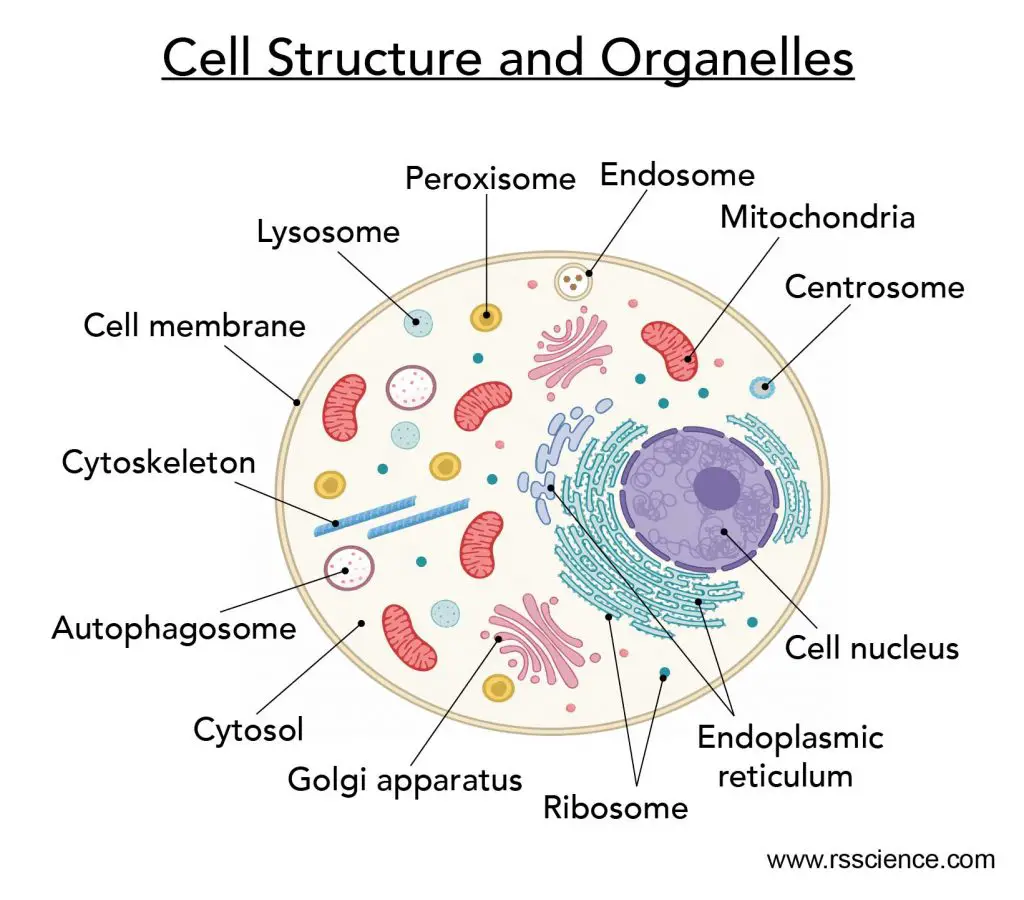
[In this figure] The anatomy of an animal cell with organelles labeled.
Enclosed by this cell membrane are the cell’s constituents, including cell organelles and jelly-like fluids called cytosols with water-soluble molecules such as proteins, nucleic acids, carbohydrates, and substances involved in cellular activities.
The cell membrane, therefore, has two key functions:
1. To be a barrier keeping the constituents of the cells in and unwanted substances/toxics out.
2. To be a gate allowing the transportation of essential nutrients into the cells and waste products out of the cells.
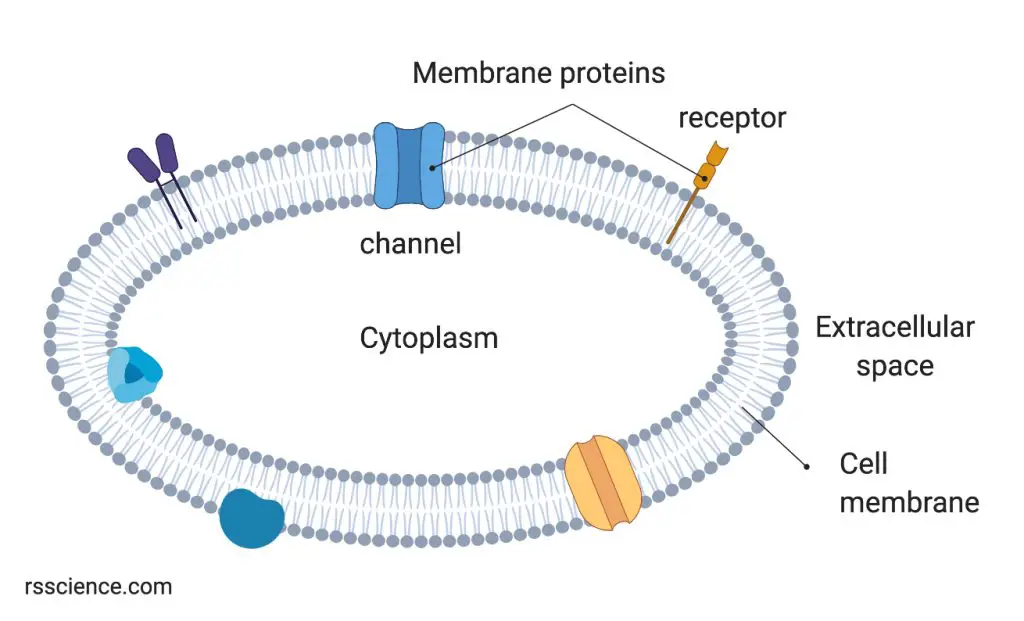
[In this figure] The cell membrane defines the inside and outside spaces of a cell.
The cell membrane is a phospholipid bilayer membrane with many proteins. These proteins could be inserted in or associated with the membrane and function as channels (controlling in and out of molecules) or receptors (receiving signals from the outside world).
The image was created with BioRender.com.
The structure of cell membrane
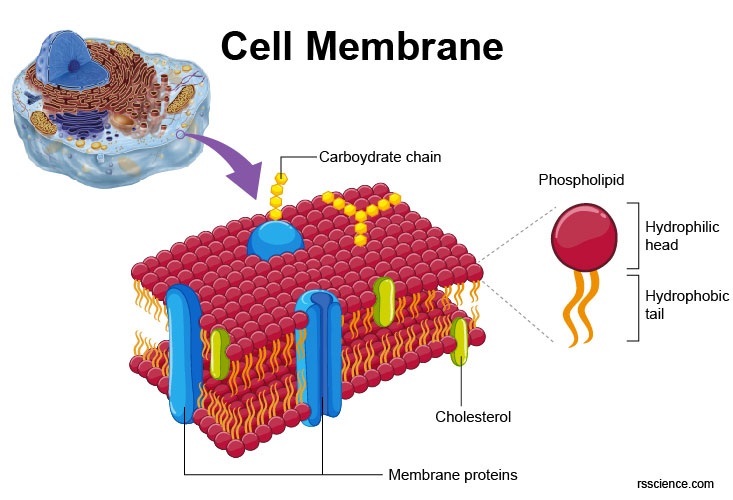
[In this figure] The fluid mosaic model of the cell membrane showing membrane proteins assembled with a lipid bilayer.
Phospholipid bilayer as a versatile biological barrier
The backbone structure of the cell membrane is a thin polar membrane made of two layers of lipid molecules, called lipid bilayer (or phospholipid bilayer). This bilayer is formed by the amphiphilic phospholipids, which have a hydrophilic (preferring water) phosphate head and a hydrophobic (preferring to stay away from water) tail consisting of two fatty acid chains.
In an aqua environment, the hydrophobic tails of many phospholipids naturally stay together with their hydrophilic phosphate heads facing the outside water molecules. The lipid bilayer forms spontaneously by self-assembly.
Another type of lipid molecule, called steroid, is also a key part of the cell membrane. Cholesterol is the most common steroid and the level of cholesterol can potentially alter the fluidity and function of the membrane.
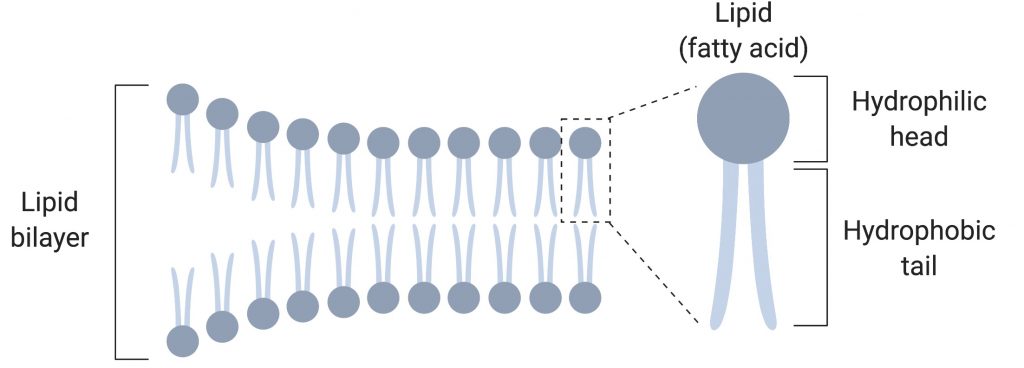
[In this figure] The cell membrane is made of two lipid films, called lipid bilayer.
Selective permeability of cell membrane
The lipid bilayers are ideally suited to keeps ions, proteins, and other charged molecules from diffusing across the membrane, even though they are only a few nanometers in width. At the same time, uncharged molecules and gases can easily cross the cell membrane. This property is called semi-permeability or selective permeability.
Selective permeability prevents free diffusion of molecules so that membranes can form compartments that keep distinct internal and external environments. This is because that the hydrophobic cores of lipid bilayers (created by the fatty acid chains) are impermeable to most water-soluble (hydrophilic) molecules. However, small molecules without electric charges, such as CO2, N2, O2, and molecules with high solubility in fat such as ethanol, can cross membranes almost freely.
This property allows cells to regulate salt concentrations and pH inside the cells. Transportation of ions across their membranes requires special permission by proteins called ion pumps or channels.
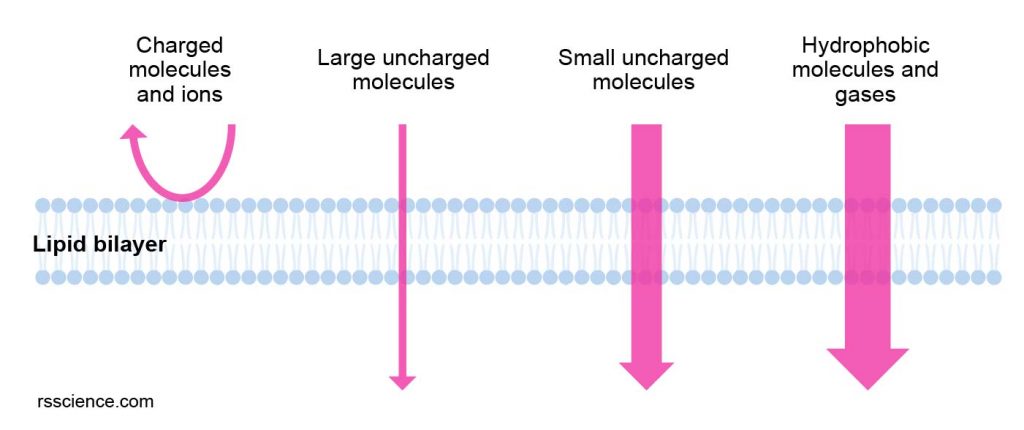
[In this figure] Selective permeability of cell membrane: the size and electric features of molecules determine their ability to cross cell membranes.
Small molecules without electric charges (e.g., gases) and oil-soluble molecules can cross membranes almost freely. Permeability is lower for uncharged molecules such as water and glycerol. The ability of large uncharged molecules, such as glucose, to cross membranes is low. Membranes are highly impermeable to ions and charged molecules.
Phospholipid bilayers are widely used for all membrane-bound organelles
Since the lipid bilayers are so great to create compartments for biochemical reactions, the membrane-bound organelles (such as the nucleus, endoplasmic reticulum, mitochondria, chloroplasts, Golgi apparatus, lysosomes, peroxisomes, and vacuoles) all use the same lipid bilayers for their membranes. We even create man-made spherical-shaped vesicle that is composed of lipid bilayer membranes, called liposomes, to help us deliver drugs and vaccines.

[In this figure] The three main structures phospholipids form in solution: the liposome (a closed bilayer), the micelle, and the bilayer.
Image credit: wiki
Membrane proteins
There are various kinds of proteins associated with the cell membrane to perform many essential biological functions. These proteins can contribute to around 50% of membrane volume. Approximately a third of the genes in multicellular organisms code specifically for membrane-related proteins.
Membrane proteins consist of three main types: transmembrane proteins, lipid-anchored proteins, and peripheral proteins.
| Type | Description | Examples |
| Transmembrane proteins | These proteins are inserted in the lipid bilayers with one or two parts facing either extracellular or intracellular spaces. | Ion channels, G protein-coupled receptors |
| Lipid anchored proteins | The protein itself is not in contact with the membrane. Instead, they anchor on the cell membrane through covalently bound to lipid molecules. | G proteins |
| Peripheral proteins | Attached to integral membrane proteins or associated with peripheral regions of the lipid bilayer. These proteins tend to have only temporary interactions with cell membranes for certain reactions. | Some enzymes and hormones |
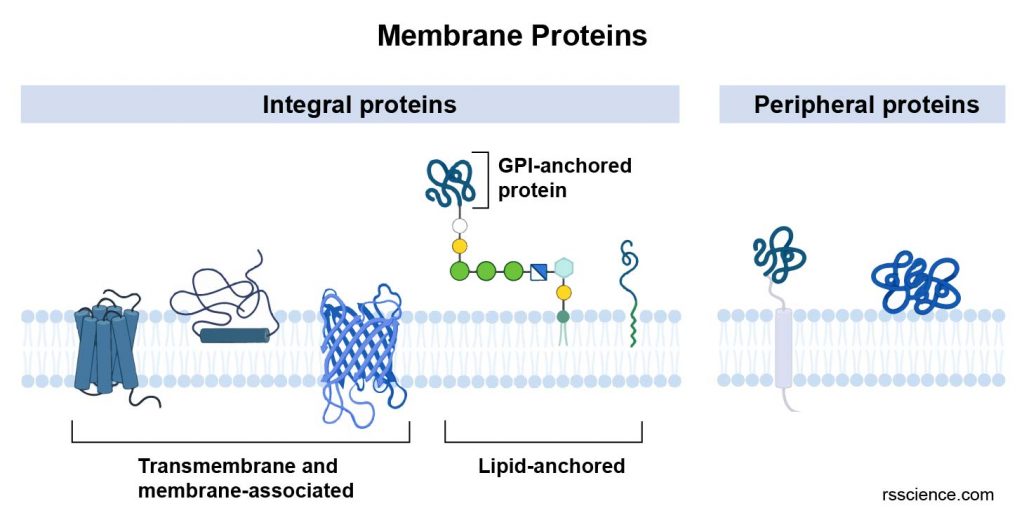
[In this figure] Schematic diagram of transmembrane, peripheral, and lipid-anchored membrane proteins.
Some transmembrane proteins present carbohydrate chains on the cell’s outer surface (also called glycoproteins).
Membrane proteins enable the cell membranes to do various functions. We will discuss these functions later.
Fluid mosaic model: What makes the cell membrane fluid?
The cell membrane is flexible and fluidic. To better describe the properties of the cell membrane, scientists explain the cell membrane appearance and functions using the fluid mosaic model.
If you zoom in on the cell membrane, you will see the ocean of lipid molecules decorated with membrane proteins, cholesterols, and carbohydrates. These molecules are constantly moving in two dimensions, in a fluid fashion, similar to icebergs floating in the ocean. There is no consistent pattern or arrangement of these molecules; they are more like a mosaic.

[In this figure] The fluid mosaic model of the cell membrane describes the cell membrane as a fluid combination of phospholipids, cholesterol, and proteins.
Photo source: Biology LibreTexts
The fluid property of the cell membrane is essential for many activities of cells. There are 3 main factors that influence cell membrane fluidity:
(1) Temperature: The temperature can affect how the phospholipids move and how close they stay. When it’s cold, they are closer together and when it’s hot, they move farther apart.
(2) Cholesterol: The cholesterol molecules are randomly distributed in the lipid bilayer, helping the membrane stay fluid. The cholesterol holds the phospholipids together at a proper distance, not too close and not too far. Without cholesterol, the phospholipids start to separate from each other, leaving large gaps at a warm temperature. On the other hand, without cholesterol, the phospholipids in your cells will start to get closer together when exposed to cold, making it more difficult for small molecules, such as gases, to squeeze through the phospholipids like they normally do.

[In this figure] Cholesterol is a key component of the cell membrane. The presence of cholesterol molecules can stabilize the properties of cell membrane across a range of temperatures.
(3) Saturated and unsaturated fatty acids: Fatty acids are phospholipid tails. Saturated fatty acids are chains of carbon atoms that have only single bonds between them. As a result, the chains are straight and easy to pack tightly.
Unsaturated fatty acids are chains of carbon atoms that have double bonds between some of the carbons. The double bonds create kinks within the chains, making it harder for the chains to pack tightly. These kinks play a role in membrane fluidity because they increase the space between the phospholipids, making the molecules harder to freeze at lower temperatures. In addition, the increased space allows certain small molecules, such as CO2 to cross the membrane quickly and easily.
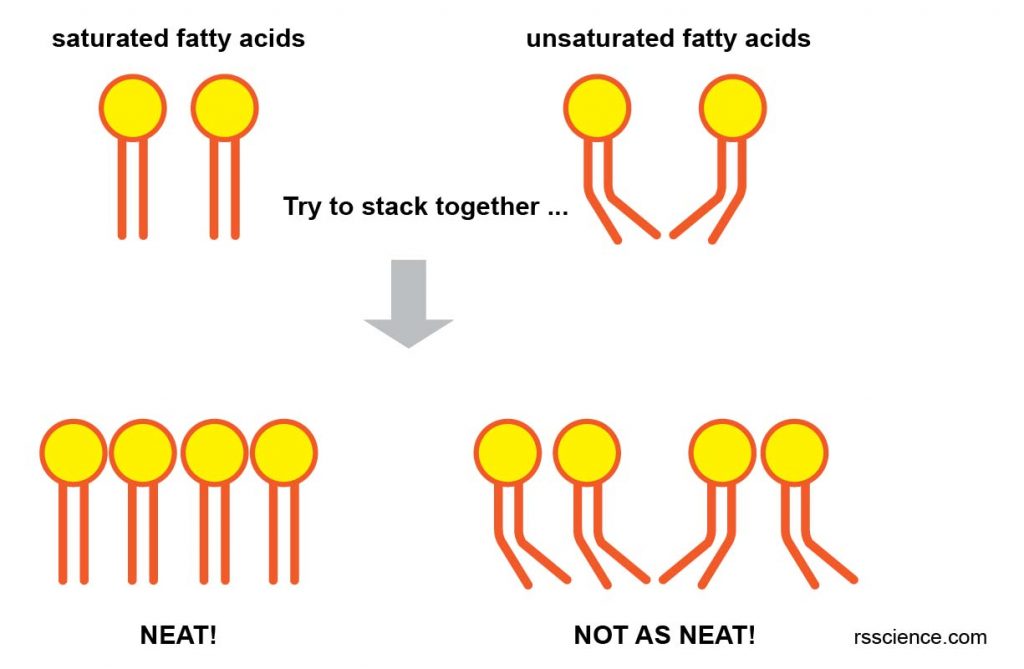
[In this figure] The composition of saturated and unsaturated fatty acids affects the fluidic of the cell membrane.
What does the cell membrane do? – The cell membrane function
Cell membrane serves as a barrier of cells, just like our skin
The cell membrane encloses the cytoplasm of living cells, physically separating the intracellular components from the extracellular environment. Plant cells possess cell walls outside the cell membrane for extra protection and support.
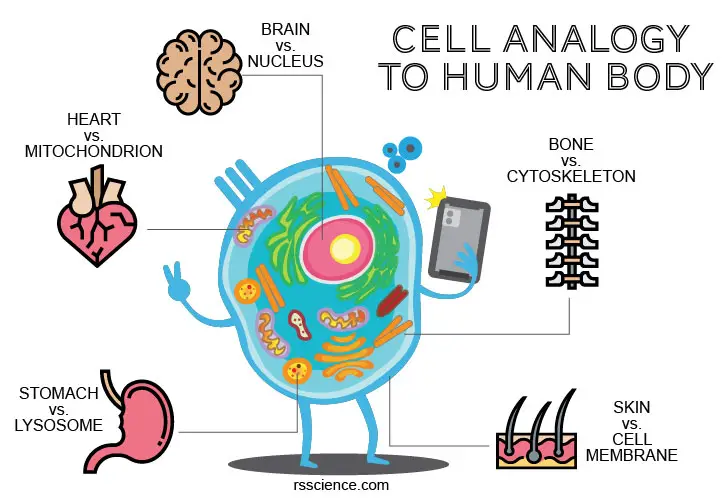
Cell membrane defines the cell shape and provides the sites for cell anchorage
The cell membrane plays a role in anchoring the cytoskeleton to provide shape to the cell (especially in animal cells without the cell wall). The cell membrane also provides the sites to interact with the extracellular matrix and other cells. These contact points can transmit the extracellular mechanical stimuli (like pressure or shear force) into the cytoskeleton, resulting in the change of cell behavior by altering gene expression in the nucleus.
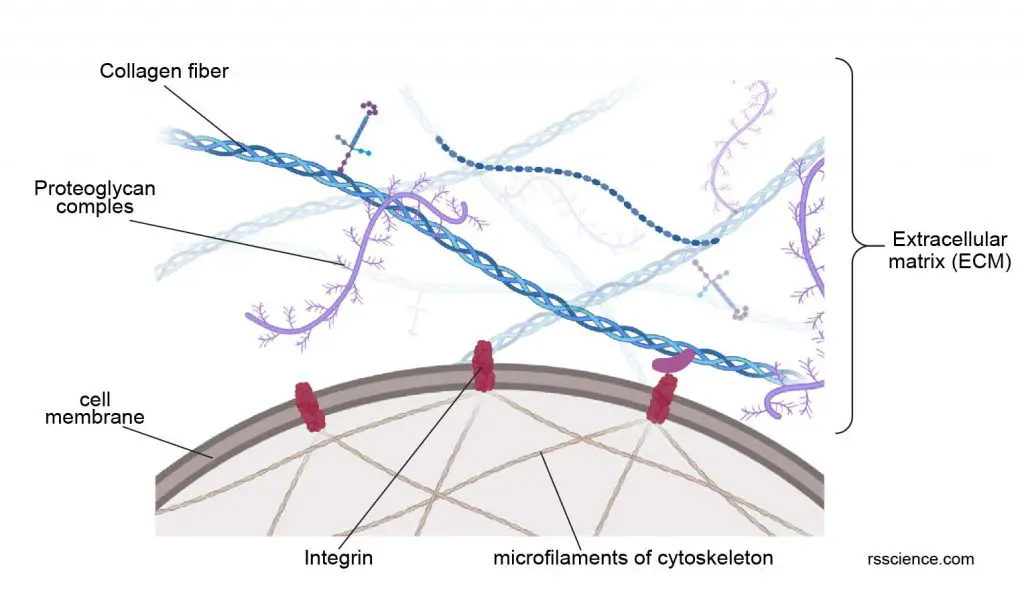
[In this figure] The cell membrane and transmembrane proteins serve as attachment points to bring intracellular cytoskeleton and extracellular matrix (ECM) together.
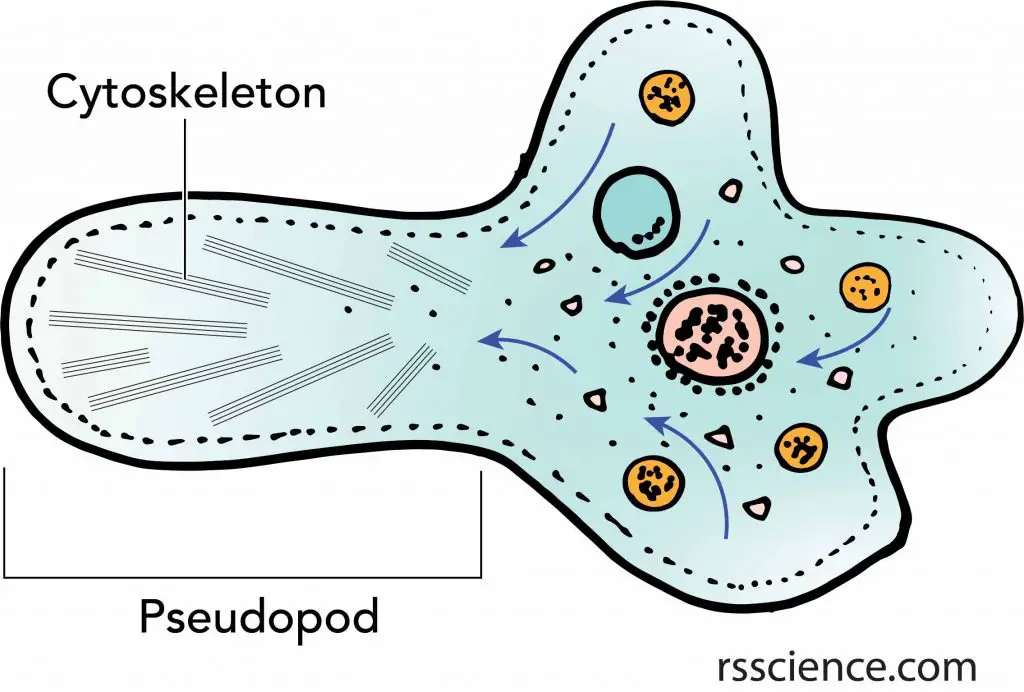
[In this figure] Amoeboid movement: an amoeba moves by stretching its pseudopods.
Underneath the plasma membrane of the pseudopods, there are organized cytoskeletons that generate the force to drive the change of the cell’s shape.
Membrane proteins control the traffic of biomolecules in and out the cells
The cell membrane is selectively permeable and is able to regulate what enters and exits the cell, thus facilitating the transport of materials needed for cell activities. The movement of substances across the membrane can be either “passive”, occurring without the input of cellular energy, or “active”, requiring the cell to expend energy in transporting it.
1. Passive diffusion and osmosis: Some uncharged molecules, such as carbon dioxide (CO2) and oxygen (O2), can move across the cell membrane by diffusion, which is a passive transport process. Diffusion occurs when small molecules move freely from a high concentration to low concentration to equilibrate the membrane. Some proteins can facilitate passive diffusion by serving as channels or carriers. Water also flows across the cell membrane through water channels (named aquaporin) by osmosis to balance the difference of salt concentration.
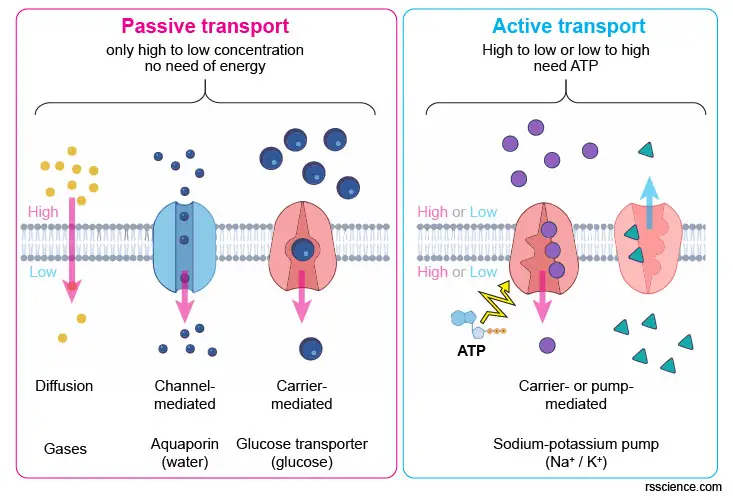
[In this figure] Depending on the nature of molecules, cells transport them in either passive or active ways. Passive transport (diffusion or protein-mediated facilitated diffusion) only moves molecules from a high concentration to a lower one. Active transport requires special transporter proteins and uses energy. Active transport can move substances in both directions.
2. Active transport: Lipid bilayer effectively repels many large, water-soluble molecules, and electrically charged ions, so cells must import or export them to survive. Transport of these vital substances is carried out by certain classes of transmembrane proteins that function as “pumps,” which force solutes through the membrane when they are not concentrated enough to diffuse spontaneously. In order to transport these substances, cells need to spend energy or ATP. Adenosine triphosphate (ATP) is the biochemical energy “currency” of the cells.
Cells eat and excrete by changing the cell membrane
Particles too large to be diffused or pumped are often swallowed or disgorged whole by an opening and closing of the membrane. To bring materials inside the cells, the cell membrane surrounding the particles undergoes invagination and engulfs by the formation of a vesicle (endocytosis). On the other hand, to remove unwanted materials from the cells, the membrane of a vesicle fuses with the cell membrane, extruding its contents to the surrounding medium, a process called exocytosis.
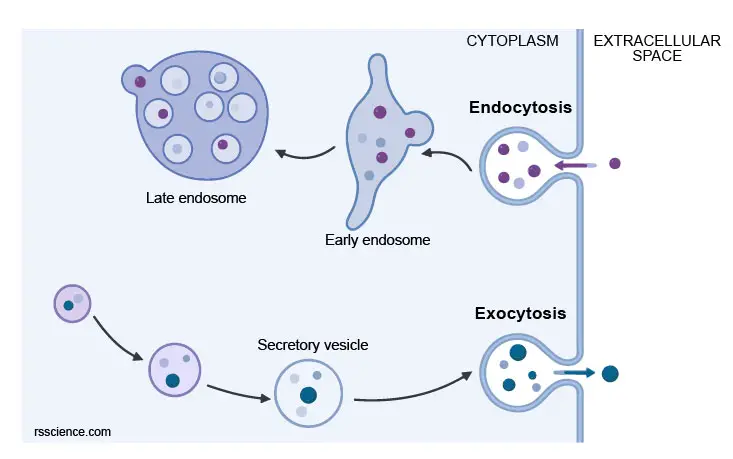
[In this figure] Endocytosis is the process in which cells absorb molecules by engulfing them. Exocytosis is a form of active transport in which a cell transports molecules out of the cell by secreting through the fusion of vesicle and cell membrane.
Cells talk to each other via direct or indirect contacts on their cell membranes
In a multicellular organism, the cells have to communicate with each other. Cell-cell communication requires special proteins on the cell membranes. The cell that wants to send a message has “ligand” proteins secreted or expressed on its cell membrane. Then, the recipient cells have corresponding “receptor” proteins to receive these messages (by binding to the ligand proteins).
The recipient cells may respond immediately but temporarily by changing cell shape or releasing certain ions. Alternatively, they may make a slow but lasting change by passing the messages into the nucleus to turn on or turn off certain genes. When two cells are close enough, they may also establish a direct exchange of molecules by protein channels (called gap junctions) spin the cell membranes of both cells.

[In this figure] Cell-cell communications via (a) direct contact and (b) gap junctions.
Photo source: Tophat
Signal transduction along the cell membrane of nervous cells
Because the membrane acts as a barrier for charged molecules and ions, they can occur in different concentrations on the two sides of the membrane. The difference in total charge between the inside and outside of the cell is called the membrane potential.
For the nervous system to function, neurons (or nervous cells) must be able to send and receive signals. These signals are electric currents generated by changing the membrane potential. The membrane potential can alter in response to neurotransmitter molecules released from other neurons and environmental stimuli.

[In this figure] Voltage-gated ion channels open in response to changes in membrane potential.
The (a) resting membrane potential is a result of different concentrations of Na+ and K+ ions inside and outside the cell. A nerve impulse causes Na+ to enter the cell, resulting in (b) depolarization. At the peak action potential, K+ channels open and the cell becomes (c) hyperpolarized.
Photo source: Lumenlearning
What does cell membrane look like under a microscope?
Under a compound light microscope, the cell membrane (only 5-10 nm) may be too thin to be seen. However, you can easily tell the boundary of cells if stained with proper dyes. That is where the cell membrane is.
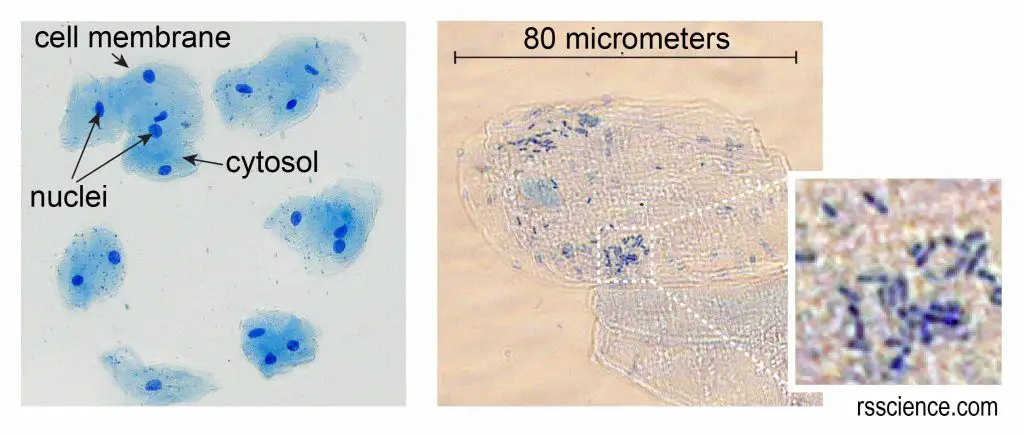
[In this figure] Cheek cells stained with Methylene Blue.
The left image is a low magnification. You can see the nuclei stained with a dark blue (because Methylene Blue stains DNA strongly). The cell membrane acts like a balloon and holds all the parts of a cell inside, such as a nucleus, cytosol, and organelles.
Plant cells have a layer of cell membrane underneath the cell wall. Most of the time, it is difficult to see the cell membrane. However, you can find the cell membrane detached from the cell wall under a hypertonic condition.

The cell membrane can be stained with fluorescent dyes that bind to lipid. This provides a useful tool to visualize cell boundaries and morphology in multi-color staining experiments.

[In this figure] (A) Human epithelial cells stained for cell membrane (red) and nuclei (green); (B) Baker’s yeast cells (S. cerevisiae) stained with membrane dyes of three colors (red, purple, and green); (C) Bacteria, E. coli stained with purple membrane dyes.
Photo source: ABP Biosciences
Electron microscopes provide high-resolution images of cell membranes. Many important scientific findings were done with electron microscopy.
Here are some examples:

[In this figure] Transmission electron microscopy (TEM) image of cell membranes of two very close cells.
Photo source: cytochemistry.
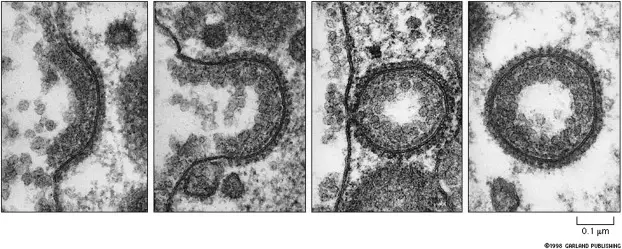
[In this figure] TEM image of coated vesicle formation in endocytosis.
Photo source: An Introduction to biological membranes
In order to study the structure of cell membrane, scientists used a “Freeze fracture” technique to tear apart the lipid bilayers and analyzed them separately under a scanning electron microscope (SEM).

[In this figure] Freeze Fracture is a technique that can be used to visualize membrane structure and protein distribution.
First, a cell is rapidly frozen. Then it is cleaved along the fracture plane that splits the lipid bilayer. Separation along this plane exposes the transmembrane proteins embedded in the membrane. Right: the SEM micrographs show bumps on the surface of the split bilayer, which actually are transmembrane proteins. This confirmed that membrane proteins are randomly dispersed throughout the phospholipid bilayer. Also, there are integral transmembrane proteins that span the entire membrane.
Photo source: wikibooks
Special cell membrane structures in special cell types
To perform certain cellular functions, some cells possess unique cell membrane structures. Here are some examples:

[In this figure] TEM image of the small intestine epithelium surface. Microvilli are microscopic cellular membrane protrusions that increase the surface area for maximizing nutrient absorption.
Photo source: Atlas of plant and animal histology.

[In this figure] T-tubules (transverse tubules) are extensions of the cell membrane that penetrate into the center of skeletal and cardiac muscle cells. T-tubules permit the rapid transmission of the action potential into the cell, allowing heart muscle cells to contract more forcefully.
Photo source: wiki

[In this figure] Electron micrograph showing the surface of endothelial cells’ membrane coated with a thick layer of carbohydrate components, called glycocalyx. Endothelial cells are the cell types that line the inner lumens of blood vessels.
Photo source: derangedphysiology
Summary
- Cell membrane is a biological membrane that separates the interior of the cell from the outside space and protects the cell from its environment.
- Cell membrane is made by two layers of lipid films (oil molecules) with many kinds of membrane proteins.
- Cell membrane controls the movement of molecules such as water, ions, nutrients, and oxygen in and out of the cell.
- Proteins on the cell membrane also involved in cell movement and cell-cell communication. For example, cells received signals from outside through different kinds of receptor proteins on the cell membrane, functioning like tiny antennas.
References
“The cell. 3. Cell membrane. Permeability, fluidity”
“Resting Membrane Potential”
“The membrane potential”
“An Introduction to Biological Membranes (Second Edition)”

